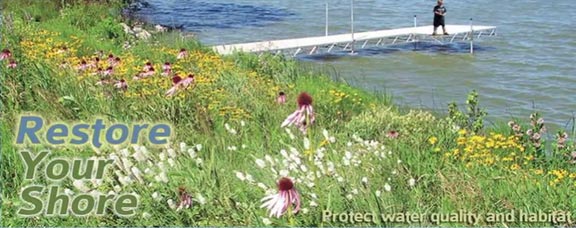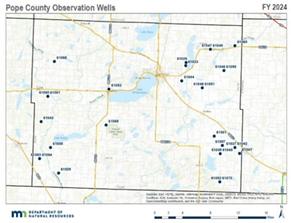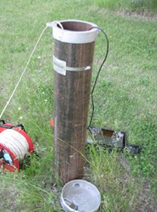Pope SWCD monitors 29 DNR observation wells located throughout the county four times a year. Water depth readings are recorded with hand measurements using an electric tape and by data gathered through a pressure transducer data connection cable on each pipe. This data is used to monitor static aquifer or groundwater levels throughout Pope County at different times of the year. The water levels are reported to the DNR to determine long term trends, assess groundwater resources and to plan for water conservation. There are over 2,000 wells across Minnesota with approximately half of them monitored at any given time. Most DNR observation wells are not used for pumping. The DNR began managing the statewide wells in 1942 and Pope SWCD began participating in this monitoring in 1980. Go to https://www.dnr.state.mn.us/waters/cgm/program.html for more info ask for Kimberly.
Shoreline Restoration
 Native shoreline habitat restorations are an excellent alternative tool compared to rock riprap to prevent lakeshore erosion, beautify shorelines, and generate habitat for pollinator species and fish nesting zones when aquatic plants are used. Native plants, when compared to traditional turf grasses have much deeper and more complex root structures; this is what gives natives the power to fight erosion and also to filter out harmful algae causing nutrients from lawn care products.
Native shoreline habitat restorations are an excellent alternative tool compared to rock riprap to prevent lakeshore erosion, beautify shorelines, and generate habitat for pollinator species and fish nesting zones when aquatic plants are used. Native plants, when compared to traditional turf grasses have much deeper and more complex root structures; this is what gives natives the power to fight erosion and also to filter out harmful algae causing nutrients from lawn care products.
The District is currently working on building a shoreline program here in Pope County. There is great potential with the vast number of shoreline miles and lake residences located within the county. There are currently 4 landowners with projects underway from a current grant. We have also submitted a grant application to the DNR for shoreline projects for 2014 and 2015. We are currently seeking applicants to generate a list of interested individuals for the potential funding. If you are interested in native restoration please contact us or call us at 320-634-5327.
Clean Water Fund Program
Thirty-three percent of the sales tax revenue from the Legacy amendment is allocated to the Clean Water Fund. Those funds may only be spent to protect, enhance, and restore water quality in lakes, rivers, and streams and to protect groundwater from degradation. At least five percent of the clean water fund must be spent to protect drinking water sources.
Protecting Minnesota’s waters is a joint effort between seven state partner agencies, who collaborate and partner on Minnesota’s water resource management activities under the Clean Water Fund.
Pope SWCD applies annually for funding for conservation projects to be implemented in the County. This past couple of years Pope SWCD partnered with the NRCS staff to work on promotions and to gain landowner interest for projects to help with these erosion concerns on the South Side of Lake Minnewaska.
This past fall Pope SWCD staff applied for a Clean Water Fund Grant to implement projects in three targeted subwatershed’s which have been identified to help reduce the amount of sediment and phosphorus entering Pelican Lake, Lake Minnewaska, and Lake Emily. The SWCD has attained about $300,000 in funding to address the nutrient impairments on Pelican Lake, Lake Minnewaska, and Lake Emily. Funding received will be able to complete around 20+ projects in these areas which will help achieve goals in the County Water Plan.
If you are located in one of these target watersheds contact the SWCD office for more information.
State Cost-Share Program
The State Cost-Share Program was created to provide funds to Soil and Water Conservation Districts (SWCDs) for the implementation of conservation practices that protect and improve water quality by controlling soil erosion and reducing sedimentation.
Through the State Cost-Share Program, landowners can request financial and technical assistance from their local SWCD for the implementation of BWSR-approved conservation practices. This program provides up to 75 percent of the total eligible costs of a practice.
Grant funds are generally available to SWCDs at the beginning of the state’s fiscal year. In order for SWCDs to receive funds, they must have on file an approved annual plan of work, annual report (including financial statements), and comprehensive plan or resolution to adopt the county’s comprehensive plan.

